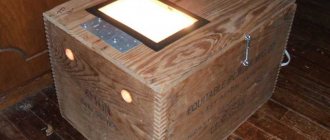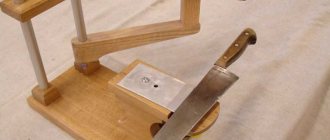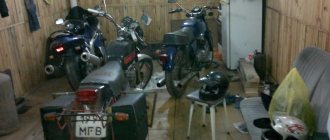Major brands that produce shaped paving elements (FEM is the professional name for paving slabs) use a forming and unmolding table to increase productivity and reduce manual labor. To produce a small amount of FEM, an individual developer only needs to make a molding vibrating table for paving slabs with his own hands from rolled metal or scrap materials (for example, used passenger car rubber).
Purpose of the vibrating table
The main task of devices such as a vibrating table is to improve the quality of produced consumables by increasing their density; moreover, they significantly speed up production and reduce the amount of effort that had to be spent.
The vibrating table can be used in the future not only for paving slabs, but also for the manufacture of a large number of other materials.
In order to prepare paving slabs or mix concrete, it is necessary to increase the density of the working mixture. Surely you want to know how to make a vibrating table with your own hands, as well as what it is needed for and how it works.
The main principle of operation of this equipment is the creation of vibrations, thanks to which the mixture will fill all empty, unfilled areas of the mold, as well as release air from the mixture, eliminating the possibility of air bubbles appearing inside. Therefore, if you need to mix concrete and make special parts or blocks from it, you should create a vibrating table right at home.
Thanks to your skills and aspirations, it is possible to create a tool that will be of the same quality as a store-bought one, the main thing is to understand how this tool works and why it is needed. The table itself looks like an ordinary iron table, the legs of which contain hinges and springs.
Manually driven
The beauty of the concrete shaking machine is its automatic operation. But sometimes money is tight, there are no tools and materials, and there is no hammer drill. In this case, you can assemble a tolerable unit from scrap materials found in every garage.
You need a wooden board, slats, a hammer, nails and 2-3 car tires.
- Place slats around the perimeter of the shield so that the containers with concrete do not move.
- Place the tires one on top of the other, and place a shield on the top one.
- Place forms with concrete mixture on the shield.
- Tap the edge of the shield with a rubber hammer to create vibration.
How does a vibrating table work?
A vibrating table designed for creating paving slabs and made with your own hands most often includes the following parts and components:
- powerful, secure and stable frame.
- a moving part that is subject to vibration.
- springs that will compensate for vibrations.
- a special motor that will cause vibrations and have a direct effect on the workpiece.
To learn how to make a vibrating table, you need to understand how it works.
According to the laws of physics, vibration can propagate in several directions; this same property is used in vibration devices, which are mainly distinguished only by the presence of a special vibrator motor.
Depending on the location of the engine, the direction of vibration changes exactly the opposite. If you install it at an angle, the vibration will follow in several directions at once.
The frames on which everything rests are located on a flat surface. Compensatory springs are attached to them, only then comes the vibration motor and the plane for forming. Vibration travels within the frames and table surface from the vibration motor to the workpiece.
Assembly order
The production of a vibrating sieve begins with the assembly of a supporting frame from wooden blocks in accordance with the drawing. To increase the strength of the structure, it is recommended to make connections of wooden parts with reinforcement with metal corners and plates.
After this, guide rails must be secured to the inside of the base frame as a support for the movement of furniture rollers. The guide angles are fastened together into a single structure using transversely installed wooden blocks. To reduce vibration levels during operation, 6 or 8 rubber shock absorbers must be installed between the corners and guides.
To secure the drive for a vibrating sieve made from an electric drill, jigsaw or saw, on one side of the upper part of the support frame it is necessary to provide a platform corresponding to the size of the power tool.
After the support frame is assembled, a plywood gutter is made and installed. The processed material will flow through it into the collection container. A metal gutter is more difficult to make, but it will provide a longer service life.
At the next stage, a sifting structure is assembled from two boxes, one of which with a sieve is inserted into the second.
On one short side the boxes are fastened together using a piano hinge.
Furniture rollers are attached to the bottom of the outer box without a bottom (frame), which ensure ease of movement of the boxes along the rails on the supporting support.
The size of the metal mesh cells is determined by the fraction of the bulk material that will be sifted. Fastening the mesh to the frame is best done using metal tape and self-tapping screws.
The working body of the power tool is connected to the external movable box using a spring connection, which will provide smoother vibrations during operation of the mechanism. Translational movements from the electric drive are transmitted to the boxes, and as a result of their vibrations along the guides, the material poured into the inner box with a mesh is sifted.
The electrical power consumption of the mechanism depends on the power of the installed power tool. It should be noted that the more powerful the electric saw, the larger the dimensions of the vibrating sieve can be made and thereby process larger volumes.
If you use an eccentric, then you can use an electric drill as a power unit. In this case, the tool is installed sideways to the drawers and the drive mechanism will perform oscillatory movements.
What is needed to make the device
To make a homemade vibration table, first of all you will need the following materials:
- a sheet of metal, the thickness of which is up to 10 millimeters, to prepare a platform for vibration exposure.
- corners from 20 by 20 millimeters to 35 by 35 - to create sides.
- steel pipe, the diameter of which is from 40 to 60 millimeters - for frames.
- electrodes for welding and the welding machine itself.
- steel springs with a diameter from 40 to 55 millimeters and a length from 145 to 210 millimeters.
- an electric motor that will create vibration for the vibrating table.
- wires to create an electrical system and provide power.
- primer to prevent the table from aging and rusting.
It is worth noting that the vibrating table can be made from chipboard and plywood boards, but this will significantly reduce the lifespan and safety of work, but will be a budget option.
Do you need to bother?
What kind of vibrating table do you use?
HomemadePurchased
If the manufacturing process seemed too complicated to you, let's touch on the issue of productivity and payback. A regular vibrating table allows you to make up to 60 square meters of tiles per day. This is enough not only for the construction of a private parking lot, but also for the production of paving slabs for sale.
If you do not shake the concrete, the tiles will become fragile and such products are not suitable for sale. If you buy an assembled device, it will be expensive and the return on investment will be lower.
Preparation of parts and blanks of the device
The frames are the main element of this device, which bears the entire load when using it. They are created from metal pipes, which are placed perpendicular to the surface of the home workshop and fastened together, for example, with metal scraps or fittings.
Note!
- Do-it-yourself compressor: selection of materials and tools for assembly at home + step-by-step instructions for making and assembling yourself
- Homemade products for the garage with your own hands: options for products for arranging a garage, detailed diagrams and drawings for creating with your own hands
- Do-it-yourself press - design features, choice of manufacturing materials. Step-by-step instructions for making it yourself + simple diagrams and drawings
The height of the support frames should be no higher than a meter; in this case, working at the vibrating table will be as convenient and comfortable as possible, because the height will be optimal.
To develop dimensions that are right for you, you should create your own vibrating table drawing. To ensure that the vibrating table is stable and that none of its corners are lower than the others, you can weld plates to the frames, which will also adjust the tilt of the table.
On top of the frame of this device, a place should be prepared for attaching springs that will compensate for excessive vibration.
The size of the prepared space depends on the size of the springs themselves, however, it should not exceed or be the minimum possible, because although the springs should not be fixed, too much free space will have a bad effect on the result.
To avoid such mistakes, be sure to watch a video on how to make a vibration table with your own hands. After completing all preparatory operations, the frames must be cleaned of dirt and welding marks, and then painted or primed.
Note!
- Do-it-yourself winch: classification, manufacturing materials, description of work stages + instructions for DIY construction
Do-it-yourself clamp - step-by-step production and description of options for using a clamp
DIY knife | A step-by-step description of how and from what materials to make a homemade knife
Principle of operation
A universal unit that facilitates the molding process functions as follows:
- the base of the vibrating table frame is rigidly attached to the floor surface;
- the power cable is connected;
A correctly set vibration amplitude guarantees uniform distribution of the solution over the vibroform and its gradual hardening
- a form filled with solution is installed on the working platform;
- the vibration motor is turned on by pressing the corresponding button on the remote control;
- a process of intensive compaction is carried out, as a result of which air bubbles come out of the solution and the mixture settles, becoming more dense;
- the supply of electrical energy is turned off;
- containers with molded products are removed from the horizontal plate;
- the next cycle of vibration compaction occurs according to the given algorithm.
A self-made vibrating table and an industrial unit work on the same principle.
Vibration electric motor for table
In order for the level and strength of vibration to be sufficient, motors with a power of one-half to one and a half kilowatt hours should be used. It needs to be unbalanced.
To do this, you need to put the pulleys on the motor shaft. A bolt needs to be inserted into one of its sides, thanks to which you can change the strength of the vibrations by adjusting the position of the bolt.
However, this is a trick; the manufacturer did not count on such bypasses of the system, which means this will primarily lead to wear and tear on the equipment. Under such heavy loads, the engine will not last long.
Result
Marsohod001 is absolutely satisfied with the result of his work.
Marsohod001
The result exceeded all expectations - the radio is practically inaudible and does not interfere with sleep at all. The height of the ceiling before soundproofing in the lowest place was 248 cm; on average, it decreased by 7–11 cm, due to the difference in the floor slabs. So there is no feeling of a squat ceiling. Goals achieved with minimal costs.
aauperm, which made a similar ceiling, confirms the effectiveness of the technology.
aauperm
I can say about the resulting effect that conversations became practically inaudible, and the stomping became 50% quieter.
How to set up an electric motor
You can adjust the engine to the power required for the vibrating table in another way, but this method cannot be adjusted: you simply need to cut off the pulley from one part or attach nuts to it.
The design of these electric motors includes an unbalancing device, which allows you to exceed the maximum load threshold and withstand stronger vibrations. This improves the quality of work and the quality of the final result.
Note!
- DIY vices: simple and reliable homemade vices from A to Z (190 photos)
Do-it-yourself grain crusher - operating principle, types and features of creating a device for processing grain crops
DIY concrete mixer | A visual aid on how and what to make a concrete mixer yourself
To install the motor, a beam is attached to the reverse, lower side of the surface of the vibrating table, on which ears are specially prepared so that the motor can be hung on them.
Thanks to this arrangement, the vibration will be directed directly to the surface of the table and the workpieces will be of the highest quality.
As mentioned earlier, the motor can be mounted in either a vertical or horizontal position, however, for maximum quality it should be installed in a rotated position so that vibrations can go in several directions at once.
Please note that the engine must be protected from external influences of moisture or active mixture that will form on the back side of the vibrating table.
Dimensions of main structural elements
Before starting to assemble a sand vibrating screen, it is recommended to draw an assembly diagram or a simple assembly drawing. This will simplify the assembly work and help determine the order in which they should be performed.
Recommended dimensions of the supporting frame (base):
The length of the outer box without a bottom should be equal to half the length of the supporting frame. The width is 100 mm less than the width of the base, the depth is at least 120 mm.
The dimensions of the inner box with a mesh bottom should ensure its easy removal from the inner frame for free overturning and release of accumulated waste. The outer and inner boxes are connected along the short side with a piano hinge, as a result of which there is the possibility of lifting and tilting the inner structure.
Second setup method
There is another option for installing an electric motor on a vibration table. It consists in the fact that the motor is mounted on frames on which the vibration table rests. That is, the vibration is directed to the entire table along with the frames, and not just to the steel plane.
Only the vibration mechanism is attached to the bottom surface of the table, which must be connected to the main electric motor using belts or a pulley. You can easily do all this with your own hands or, in extreme cases, buy it in a store.
The motor that you mount on the frames should not be in contact with the floor and should be protected from external influences of moisture or active mixture.
Alternative solution
The option described above is a full-fledged, reliable table that can work for hundreds of hours. But sometimes there is no time and money to make such a machine. There is a way to quickly assemble an improvised construction vibrator with your own hands.
A steel plate is fixed to the edge of a vertical surface (metal or wooden panel). The opposite end is wrapped with rags or other shock-absorbing material, after which the structure rests against the wall. A hammer drill is leaned against a steel plate; instead of a drill, a piece of pipe is installed in the chuck. The vibration from the switched-on hammer drill is transmitted to the working surface, so you can place containers with concrete.
The lightest version of a vibrating table
If you urgently need to make a small batch of paving tiles or certain parts made of cement, but you have neither the time to make a large device nor the money to buy a factory one, then this option will be quite suitable for you, because it is a budget analogue, simple and fast in building.
It can be easily done in one day. To do this, you will need plywood sheets, a rubber tire from a car and a low-power electric motor.
To begin, mount the existing electric motor on a plywood or metal sheet. Then place the tire on the ground, and place the plywood with the engine so that the engine is inside the tire, but not touching the ground.
Rubber will absorb vibration like frames, but this will not be enough for quality homemade tiles. However, this option will definitely be enough for a small batch.
A vibrating sieve can also be considered a similar option, which you can also easily make with your own hands.
Rating of popular factory models
If you don’t have time for assembly, and factory quality and warranty come first, buy one of the popular models of vibrating tables. The average price of vibrating tables on Yandex Market is 20-25 thousand rubles. Small specimens are sold for 6-8 thousand, but their productivity is low, and they are designed for working with plaster.
VO-100 220V 220V
Dimensions: 1000x700x800 mm.
Weight: 155 kg.
Price: 27 755.
VO-60 220V 220V
Dimensions: 600x600x700 mm.
Weight: 105 kg.
Price: 21 475.
VO-50 42/380 V 42/380 V
Dimensions: 500x500x600 mm.
Weight: 90 kg.
Price: 18 576.
VS-180 42/380V 42/380V
Dimensions: 1000x500x800 mm.
Weight: 140 kg.
Price: 25 679.
VS-950 42/380V
Dimensions: 2000x1500x800 mm.
Weight: 600 kg.
Price: 79 769.
EV-342 3-380V
Dimensions: 980x480 mm.
Weight: 180 kg.
Price: 57 100.
Recommendations
Creating a vibrating table at home does not take as much effort as it might seem at first glance.
Household tools may well be enough to make a relatively easy vibrating table. All you need besides tools is a little experience and knowledge, as well as following instructions and safety precautions.
Remember that the required dimensions, as well as the characteristics of the vibrating table, depend on what materials you use. It is preferable to choose the highest quality, but within reason.
Necessary materials
To make a frame, two drawers and other elements of the mechanism, you will need:
- wooden blocks 60x70 mm;
- plywood 20 mm thick;
- 6 rubber or spring shock absorbers;
- 4 or 6 furniture casters with mounting frame;
- piano loop with a length of at least 500 mm;
- metal corners for guide rails;
- metal plates or strips to strengthen wooden structural parts;
- screws, bolts and nuts.
Photos of do-it-yourself vibrating tables
Purchasing a unit
If you still decide to purchase a unit, you need to take into account both the main criteria and minor nuances that will make the work easier or increase its service life. However, we cannot fail to mention the manufacturers of vibratory ramming devices.
Equipment from European manufacturers is especially important. German technology is distinguished by its reliability and long service life. Even rental samples show good quality and speed of work. All equipment has a double safety margin. Wacker, Weber, Ammann, Bomag produce professional equipment.
Israeli Shatal and Czech NTC have fewer resources than the Germans, but they also turn out to be good workers at construction sites and on private property.
South Korean equipment from Jeonil Minery is not inferior to products from the Czech Republic or Israel. In the Asian market, this is the best offer among all vibration units.
Russian products from, Motoprom and SZPO are inferior to average European models in terms of convenience and functionality. However, modernization continues, and new, more advanced models appear on sale.
The Chinese, as usual, charge a price. Their products are only suitable for occasional, light-duty work. Among the mass of unknown manufacturers, the companies TEKPACK, MASALTA, DYNAMIC, CIMAR stand out.
The use of a vibrating machine is important not only when working with sandy soils, but also when compacting crushed stone
Do you want to know how to assemble a vibrating plate with your own hands? I will tell you what materials and tools are needed and give step-by-step assembly instructions. I will also explain its principle of operation and introduce the types of this equipment.
External speed control unit
Since the electric hacksaw blade moves too quickly, we install a separate speed control unit (with a built-in switch and automatic fuse), which will help you choose the optimal mode of forward movement of the vibrating screen and adapt its operation for different bulk materials. In this case, the power saw switch is locked in the “on” position. You can dispense with a separate adjustment unit if you use a fairly “low-speed” electric saw as an electric motor.
It is better to cover the electric saw itself with a protective cover to prevent the ingress of cement, sand or other dust (easy to make from a plastic bottle of a suitable size). With fairly simple changes in the design of the frame, you can use an electric drill (preferably with a built-in rotation regulator) as the main engine, installing a pin with a reciprocating eccentric attached to it instead of a drill.
The video shows another simple design of a vibrating sieve, using an electric jigsaw as a motor:











